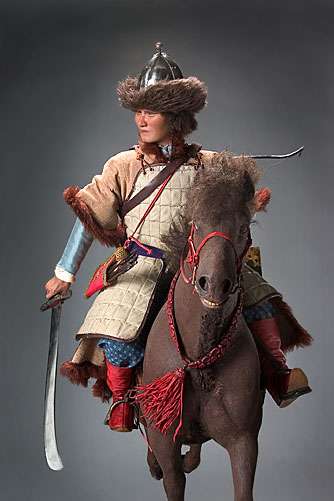Attila the Hun

No known image of Attila exists from life. This is a likeness by artist and historian George S. Stuart created from his physical description mentioned in historical records.
Attila was the ruler of the Huns from 434 until his death in 453. He was leader of the Hunnic Empire, which stretched from the Ural River to the Rhine River and from the Danube River to the Baltic Sea. During his reign he was one of the most feared enemies of the Western and Eastern Roman Empires, earning him the sobriquet "The Scourge of God". He also attempted to conquer Roman Gaul (modern France), crossing the Rhine in 451 and marching as far as Aurelianum (Orléans) before being defeated at the Battle of the Catalaunian Plains (aka the Battle of Chalons). Subsequently he invaded Italy, devastating the northern provinces, but was unable to take Rome. He planned for further campaigns against the Romans but died in 453.
Attila the Hun is the Trope Namer for:
Attila the Hun provides examples of the following tropes:
- Affably Evil: If you see him as evil, that is. He listened to the appeals of Pope Leo and refused to sack the already weak city of Rome. He was also known for his hospitality.
- Alternate Character Interpretation: Depending on where you live, or what sources you listen to, Attila was either an evil bloodthirsty warlord or a great and noble king. In Real Life he was probably somewhere in-between.
- Cain and Abel: He killed his older brother Bleda, who, according to some sources, tried to kill him as well.
- Iconic Item: The Sword of Mars.
- Impaled with Extreme Prejudice: One of his methods of execution.
- The Napoleon: He was apparently rather short.
- Out with a Bang: Reportedly died on his wedding night.
- Sacred Hospitality: One of his more redeeming qualities.
- Sobriquet: "The Scourge of God"
Works featuring Attila:
Film
- He appears as one of the many wax figures brought to life in Night at the Museum.
Literature
- Attila appears in Dante's Divine Comedy in the seventh circle of Hell.
- Attila appears in rather mythologized form in the Nibelungenlied and the Volsunga Saga under the name of Etzel or Atli.
- The White Stag: A children's book by Kate Seredy, telling a highly fictionalized Origin Story for the Huns.
- Several Historical Fiction novels, including a trilogy by William Napier and single novels by William Dietrich and Michael Curtis Ford.
Live-Action TV
- Defeated Alexander the Great in Deadliest Warrior.
- Attila: A miniseries starring Gerard Butler.
Newspaper Comics
- An occasional rival to Hagar the Horrible.
Video Games
- Attila's is one of the historical campaigns you can play in Age of Empires II: The Conquerors, showcasing the Hun faction that was included in that expansion.
Western Animation
- In the episode "Kif Gets Knocked Up a Notch" of Futurama, Attila was one of several simulations of evil characters accidentally brought to life (others included Jack the Ripper and Professor Moriarty)
This article is issued from Allthetropes. The text is licensed under Creative Commons - Attribution - Sharealike. Additional terms may apply for the media files.